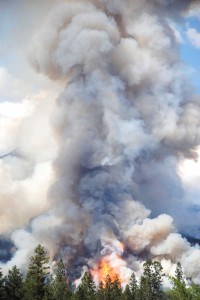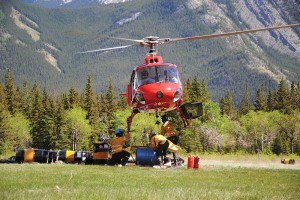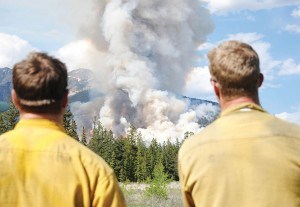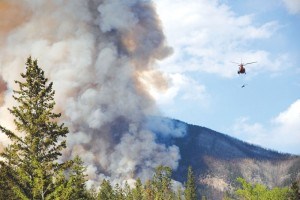
A massive plume of dark grey smoke swirled over Jasper National Park as fire crews from Parks Canada carried out a prescribed fire about 20 km north of the Jasper townsite, May 23.
The deliberately set fire was part of Parks’ ongoing efforts to reintroduce fire as a natural process in the park’s ecosystem.
“In a natural fire cycle this area would have burned frequently in the past,” said Kim Weir, a fire communications officer for Parks.
“This prescribed fire will help us change the landscape back to the healthy, historical norm that used to be here before fire suppression,” she said, explaining wildfires in the park were suppressed for more than 70 years.
Historically, parts of the valley bottom would have burned as frequently as every five to 10 years and would have resembled a douglas fir savannah, explained Weir, noting that douglas fir are fire resistant.
Visible from Highway 16, fire crews used helicopters to burn 500 hectares of forest on the slopes of Mount Greenock, on the west side of Athabasca River. The area is known as the Vine Creek fire unit.
Prior to the prescribed burn, Parks had already burned about 225 hectares in preparation of the big event. In fact, the Vine Creek prescribed fire was in the works for more than eight years, but was continually postponed as Parks waited for the perfect conditions.

“Every prescribed fire has a prescription or a strict set of conditions that we have to fulfill before we actually ignite the prescribed fire,” explained Weir.
This includes defining the boundary of the fire, where to place fireguards, what the fuel or flammable vegetation is like, weather, moisture levels, humidity levels, wind direction and speed, terrain, as well as the atmosphere for proper smoke venting and fire behaviour.
“There are a lot of details that have to align before we can carry out a fire and because of that it can take years to get those right conditions to align perfectly,” she said, adding Parks has been working on the Vine Creek prescribed fire since 2007.
“It’s been difficult to get the right conditions to carry this one out so we’re really, really pleased we finally got the right conditions today.”
One of the objectives of the fire was to extend a firebreak that spans the Athabasca Valley near Jasper Lake to stop fires from burning eastward. The Vine Creek prescribed fire will compliment a number of other firebreaks, both natural and prescribed, that are already in place, such as the Syncline fire that burned in 2003.

The Vine Creek fire was also designed to reduce the available habitat for the mountain pine beetle, which has been spreading eastward through the park.
“We’re not necessarily burning where the beetles are, we’re actually removing habitat in advance of the beetle coming to this area,” said Weir.
Another objective includes restoring the habitat for whitebark pine, a species at risk.
Over the past 70 years, fire suppression has allowed lodgepole pine and spruce trees to flourish in the park, thereby reducing the habitat available for other species, such as the whitebark pine.
“We actually selectively burned around whitebark pine stands identified in the unit and then when we burn the main unit this will actually create better habitat for whitebark pine to re-colonize,” said Weir, before the fire was lit.

The prescribed fire was nearly put on hold again last week after a minor wildfire was spotted in the east end of the park May 22. The fire was discovered along the railway tracks across the Athabasca River from Pocahontas.
Fire crews from Alberta Environment and Sustainable Resource Development immediately responded and after liaising with Parks, air tankers were brought in to drop fire retardant on the area.
The fire was quickly suppressed and contained to about the size of a football field.
The fire was immediately put out because it was located in the “intensive zone” or “red zone,” explained Weir.
“If a fire starts there, we’ve predetermined that we will head out and extinguish it immediately because the safety of people, facilities and neighbouring land is our highest priority,” she said.
Parks monitors every wildfire in the park, no matter the size or location.
“On the other end, we have the extensive zone or the green zone and this is basically the backcountry with very few facilities and very few people, if any,” she said. “If a wildfire started there, depending on conditions, we may very well let that burn naturally and let it take its course within predetermined or predefined areas that we’ve set out.”
Between the two extremes is the “intermediate zone” or “yellow zone.” These areas may have a few facilities and pose some risk, but the fire may still be allowed to run its course.
“This is going to be looked at on a case-by-case basis,” said Weir, explaining decisions will be made based on a fire’s location, weather, time of year and the potential impact on people and property.
“We may let parts of it burn while putting other parts of it out.”

Leading up to May 23, Weir said she contacted more than 300 stakeholders in the region to inform them about the fire.
“Every time we have a wildfire or a prescribed fire, I let folks on that list know what’s going on,” she said, referring to an email list.
“We enjoy a high level of support in our fire management program, specifically for prescribed fires, because people in the mountain parks really understand the importance of the natural process of fire.”
Prior to igniting the fire, a team from FPInnovations, a forestry research company, planted four cameras and several sensors in a previously burnt area to measure the fire’s intensity and temperature to help improve firefighter safety.
“Eventually we will use the information to understand how large an area you would need to go into to have a refuge,” said Jim Thomasson, a wildfire researcher with the company.
To carry out the prescribed fire, 24 Parks staff were on hand, including three fire crews and four helicopters.
The fire was originally expected to take at least two days to complete, but because of the weather conditions, fire crews were able to complete the prescribed burn in a single day.
Two crews spent the following days “moping up” the charred remains and extinguishing any smouldering embers.
The area will remain closed until fire managers deem it safe. This includes Vine Creek Trail and Celestine Lake Road.
“This is just one of many prescribed fires that we actually have planned for Jasper National Park and I cross my fingers that we get conditions to carry out those as well,” said Weir.
Paul Clarke
[email protected]
